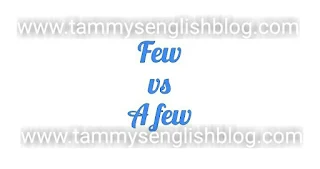Sometimes, our utterances
or sentences convey meanings that are totally different from our original
thoughts due to our inappropriate use of words. This is always the case when we
are to choose between two words that are morphologically identical but semantically
different. Examples of such words are "a few and few", "a little and little".
These words might look alike on the surface but do not carry the same meaning; hence, we should apply ultimate carefulness when using them.
Few, a few, little and a
little function as quantifiers when they precede nouns. They tell the quantity of the nouns that follow them. In order not to deviate from the thematic preoccupation of this article, only "a few" and "few" will be discussed.
Both "a few" and "few" mean small quantity and are
generally used with countable nouns. In English, countable nouns are nouns that
can take plural markers; e.g., chair/chairs; man/men; lady/ladies;
church/churches etc. So, you can say "few books", "a few
men", "few chairs" etc.
However,
“few” is used when the quantity of the item
is so small that it is almost insignificant. “Few” shows that
the quantity of the item is small and can't be useful for its purpose. In a
nutshell, "few" conveys dissatisfaction and a negative idea.
On its part, “a few” refers to a significant
number which can be used for a purpose. When a speaker makes use of "a
few" before an item, he/she tries to show that such item can adequately serve its purpose
although its quantity is small. For example, a student who has a small quantity
of books can say "I have a few books" if he/she knows that the books
are enough for passing his/her exams. "A few" conveys satisfaction
and a positive idea.
Sentence examples
1. Few were present. (Not many at all)
2.
A few persons were present. (Not many, but can serve the purpose)
3. I have few shirts. (Not many at all)
4. I have a few shirts. (Not many, but enough for the necessary outings)
